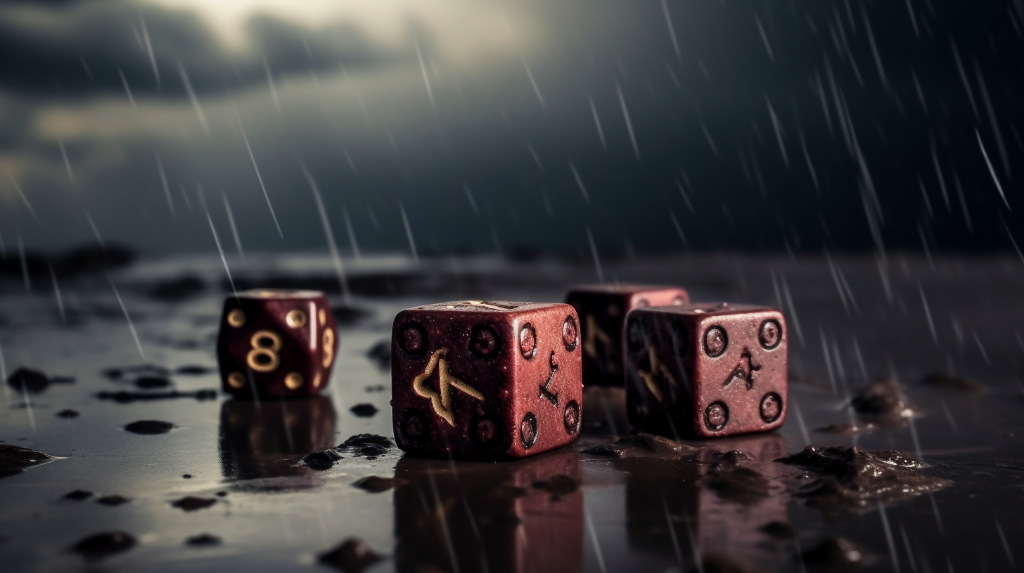
Picture this: In the heart of a chaotic battlefield, an adventurer, cloaked in the aura of arcane power, raises her staff towards the tempestuous sky. Suddenly, the heavens respond to her call, the clouds roil and churn, and a bolt of pure, crackling energy descends upon her foes. This is the power of Call Lightning, a formidable spell in the Dungeons and Dragons 5th Edition.
Call Lightning, a spell as volatile as the storm it beckons, is a staple in the arsenal of many a spellcaster in the realm of D&D 5e. This spell is known for its destructive power, versatility, and the sheer spectacle of its effects.
In this post, we will explore the intricacies of this spell, illuminating its mechanics, potential strategies, and the many ways it can electrify your D&D sessions.
Unleashing the Storm: Overview of Call Lightning
Call Lightning is a 3rd level conjuration spell available to certain spellcasting classes in D&D 5e. It requires a casting time of one action and has a range of 120 feet. The verbal, somatic, and material components needed to cast this spell include a bit of fur and a rod of amber, crystal, or glass.
The spell’s duration extends up to ten minutes, provided the caster maintains concentration. This allows the caster to call down a bolt of lightning on a location they can see within range, each turn until the spell ends.
The Power of the Skies: Call Lightning’s Damage and Effects
When the bolt of lightning descends, any creature within a 5-foot radius of the targeted point must make a Dexterity saving throw. A creature takes 3d10 lightning damage on a failed save, or half as much damage on a successful one.
But the true power of Call Lightning lies in its potential to increase in intensity. For each slot level above the 3rd, the spell’s damage increases by 1d10. Imagine the awe-inspiring sight of your enemies falling before the unleashed fury of the storm!
The Art of Storm-calling: Strategies and Tactics with Call Lightning
Have you ever considered the strategic depth behind the casting of Call Lightning? This spell, like a tempest in the hands of a skilled spellcaster, can turn the tide of a battle, creating chaos in the enemy’s ranks while raining down electric judgement.
The sheer versatility of this spell allows it to be used in a myriad of combat situations, from dispatching hordes of weaker foes to puncturing the defenses of a formidable adversary. It’s all about positioning, timing, and making the most of the stormy conditions that the spell conjures.
Mastering the Elements: Optimal Conditions for Call Lightning
When the sky above is already seething with thunderclouds, the Call Lightning spell becomes a force to be reckoned with. It’s almost as if the storm itself is eager to lend its fury to your cause, amplifying the spell’s power. But what are the ideal conditions for calling upon this storm-bound spell?
It should be noted that while Call Lightning can be cast in any environment, its true potential is unleashed outdoors, under an open sky. The higher the storm clouds can climb, the more room they have to gather energy, resulting in a more potent lightning strike. It’s as if the stormy heavens themselves become an extension of the spellcaster, an ally in the battle against their foes.
Jolting the Battlefield: Synergy with Other Spells and Abilities
Is Call Lightning a standalone spell, or can it be woven into a tapestry of magic, working in harmony with other spells and abilities? The answer is a resounding yes to the latter. The synergy between Call Lightning and other spells can create electrifying combinations that can turn the tide of any battle.
Consider, for example, combining Call Lightning with Wind Wall. The wall can serve as a barrier, protecting you while you prepare to cast your spell, and then, once the storm clouds gather, your enemies will find themselves trapped between the tempest and the unyielding wind. Or perhaps you might consider coupling Call Lightning with a control spell like Entangle or Hold Person. With your enemies ensnared and unable to evade, each lightning strike will find its mark with deadly precision.
Thunderous Limitations: Drawbacks and Challenges of Call Lightning
As majestic and powerful as Call Lightning may be, it is not without its limitations. These limitations, however, do not diminish the spell’s worth but rather add a layer of strategic depth and challenge to its use.
One such challenge is the spell’s dependency on outdoor environments. While it can be cast indoors or in caves, the 100 feet tall and 60 feet radius cylinder of storm clouds that the spell conjures must fit within the space. This means that in smaller environments, the spell can be significantly less impactful. Can you imagine the frustration of a druid attempting to call forth a storm within the narrow confines of a dungeon corridor?
Another potential challenge is the vulnerability of Call Lightning to counterspelling. Given its casting time of 1 action, a vigilant foe could, in theory, disrupt your spellcasting and prevent the spell from taking effect. It’s a game of magical cat and mouse, a duel of wits and reflexes between you and your adversary.
Conjuring Thunder: Spellcasting Classes and Call Lightning
When it comes to calling down the wrath of the skies, not all adventurers are created equal. Call Lightning, as a third-level spell, is not available to just any would-be stormcaller. So who among the spellcasting classes can harness this tempestuous power?
The Druid class, harmonious with the forces of nature, is the most iconic wielder of this spell. Conjuring a storm mirrors their ability to channel the raw energy of the natural world, making Call Lightning a fitting addition to their spellcasting repertoire. They gain access to this spell at level 5, when they are able to cast third-level spells.
The Circle of the Land Druids, with their additional access to specific terrain-related spells, can also add Call Lightning to their arsenal if they choose the Grassland terrain. This adds an interesting layer to their casting abilities, allowing them to summon a storm even in the most serene grasslands.
On the other hand, the tempestuous Clerics, particularly those who follow deities associated with storms, also have the privilege of wielding this spell. The Tempest domain Clerics gain access to Call Lightning at level 5, the same as Druids.
| Class | Level Access |
|---|---|
| Druid | 5 |
| Circle of the Land Druid (Grassland) | 5 |
| Tempest Domain Cleric | 5 |
Smite from the Skies: Roleplaying Opportunities with Call Lightning
But what about beyond the battlefield? Can Call Lightning serve a purpose in the theatre of the mind, adding depth to your character’s story and roleplaying moments? Indeed, it can!
Consider a scenario where your Druid is part of a ceremony to honor a nature deity, and as part of the ritual, they call down a small, harmless lightning storm as a display of the deity’s power. Or perhaps your Cleric uses Call Lightning as a sign of divine intervention, a testament to their deity’s might in a world of non-believers.
- Performing a ceremony or ritual in honor of a deity, calling down a harmless lightning storm as a symbol of their power.
- Using Call Lightning as a divine sign, especially in a moment of crisis or to turn non-believers.
- Creating a distraction or spectacle to divert an enemy’s attention or to make an escape.
- Unleashing a storm to change the weather conditions, potentially aiding in survival situations.
- Displaying power or intimidation in diplomatic or negotiation scenarios.
Stormy Tales: Famous Uses of Call Lightning in D&D Lore
In the annals of D&D lore, there are tales of great heroes and villains who have used Call Lightning to turn the tide of battles and alter the course of stories. It’s not just a spell, it’s a marker of epic moments, a tool that has shaped the history of many campaigns.
One such tale is that of the legendary Druid, Ellistrae of the Whispering Pines. It is said that during the Battle of the Crimson Vale, Ellistrae called down a storm so fierce that it decimated the enemy lines, turning a near-certain defeat into a triumphant victory.
Then there’s the story of Zephyros, the eccentric Cloud Giant wizard from the adventure Storm King’s Thunder. Known for his unorthodox methods, Zephyros used Call Lightning in a unique way: to power his floating tower. This not only showcases the spell’s potential for creative use but also its integration into the grand narratives of D&D.
The Roar of the Heavens: Tips for Dungeon Masters
As a Dungeon Master, it’s exhilarating to see your players harness the raw power of nature with spells like Call Lightning. But, it can also pose a challenge. How do you maintain the balance of power in your campaign when your players can summon a storm at will? And how do you weave this dramatic spell into your narrative in a way that enhances the story? Let’s explore some tips.
- Countering Call Lightning: Call Lightning is a formidable spell, but it’s not invincible. Clever enemies might seek shelter indoors or use spells to disperse the storm. Remember, the spell requires a clear path to the sky. A cunning antagonist might exploit this limitation.
- Weather Manipulation: Use the weather to your advantage. If a player frequently uses Call Lightning, consider introducing adverse weather conditions that make the spell’s use more challenging or even impossible.
- Story Integration: Incorporate the spell into your campaign narrative. Maybe the power to call lightning is a sacred ability in a certain culture or is tied to an ancient prophecy in your world.
- Environmental Effects: Don’t forget about the environmental effects of a lightning storm. A forest fire caused by a misplaced bolt could lead to a whole new adventure.
The Final Thunderclap: The Future of Call Lightning in D&D
What does the future hold for Call Lightning in Dungeons and Dragons? As a staple of the druid’s arsenal and a favorite among many players, it’s unlikely to disappear anytime soon. But how might it evolve in future editions of the game?
Will we see new variations of the spell, perhaps tied to different weather phenomena? A ‘Call Blizzard’ or ‘Call Tornado’ spell could offer exciting new possibilities. Or perhaps we’ll see new classes or subclasses that specialize in weather manipulation, providing even more options for storm-loving spellcasters.
One thing is certain: the power to command the forces of nature will always hold a certain allure. For many players, the thrill of summoning a storm and directing its fury at their enemies is a fundamental part of the D&D experience. As long as this remains true, Call Lightning is likely to continue thundering through our adventures.






